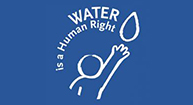By Marek Szilvasi, European Roma Rights Centre
 The Human Right to Water and Sanitation is still not a reality in Europe. All across the continent there are people living without access to clean water, and many of them are Roma. Europe is home to 10-12 million Roma people.
The Human Right to Water and Sanitation is still not a reality in Europe. All across the continent there are people living without access to clean water, and many of them are Roma. Europe is home to 10-12 million Roma people.
Since 2014 the European Roma Rights Centre (ERRC) – an international public interest organisation working to combat anti-Romani racism and human rights abuse of Roma – has been conducting research on access to safe and affordable drinking water and sanitation in Romani neighbourhoods in seven countries. We have focused on analysing problems with accessibility, affordability, and quality of drinking water resources, as well as with sanitation in Romani neighbourhoods and settlements. The research has also examined potential cases of ethnic discrimination in the distribution and availability of these public utilities.
Prior to the ERRC’s research, there was very little information available about access to safe drinking water and sanitation for Romani communities in Europe. According to the United Nations Development Programme (UNDP) Regional Roma Survey (2011), in many European countries a large proportion of Romani households were still not connected to a piped, public water supply and remained dependent on water whose quality was not tested by the competent public authorities.
The ERRC research mapped the legal and policy frameworks and conducted field research in 93 Romani neighbourhoods and settlements in Albania, France, Hungary, Macedonia, Moldova, Montenegro, and Slovakia. Out of the 93 sites visited, in 62 the Romani communities had significantly worse conditions in accessing water resources than their non-Roma neighbours. The ERRC identified these as prima facie cases of discrimination.
In 75 of the sites investigated (81%), the Romani neighbourhoods or settlements were not connected to the water mains. Moreover, in 63 places (68%), all Romani households in the neighbourhood or settlement were not supplied with tap water and a functioning sewerage system. The data did not reveal a strong correlation between the legal status of the settlements or neighbourhoods and access to water; those Roma living in formal, legal settlements or neighbourhoods were no less likely to be deprived of water, among the sites investigated.
Affordability was also a problem: the research findings indicate that more than one quarter of Roma (28%) whose situation was investigated had either been disconnected or were currently under threat of being disconnected from water supply due to payment arrears.
The research pointed out that 20% of the Romani households investigated relied entirely on unprotected water sources, such as self-made wells, natural springs and rivers. Although the public authorities were aware that self-made wells provided the only available drinking water for these communities, they failed to check the quality of the water in those wells.
Ground water in shallow wells was contaminated by agricultural pesticides and/or pit latrine faeces in 26.88% of sites considered, according to the Roma residents interviewed. High levels of natural arsenic, boron, fluoride or manganese, and contamination from animal corpses and insects, were also problems.
In more than half of the places visited (52.69%), the nearest water source was more than 100 metres away, and in some places Roma had to walk several kilometres. According to the World Health Organization (WHO), when the water source requires a walk of between 100 metres and 1,000 metres from home or five to 30 minutes total collection time, the quantities of water collected are unlikely to exceed 20 litres per person daily and hygiene practice may be compromised, resulting in a high risk to public health from poor hygiene.
The ERRC’s research reveals that the task of collecting water in the communities investigated generally falls on women and girls. More than 40% of the Roma surveyed indicated that their path to water contained obstacles such as fences, walls, highways, or private land with protective owners who take aggressive action against trespassers.
The distant public pumps or fire hydrants, which are the only source of water for many Roma, are often managed by reluctant and hostile authorities that frequently cut them off as soon as they find that Roma are using them. When there is no other possibility left to get water, Roma have to walk to the nearest shop and buy bottled water. As a result, the poorest Roma can end up paying the most for water.
Fewer than 12% of the sites visited had a functioning sewerage system. Three quarters of Romani households surveyed resorted to defecating either in self-made pit latrines or in the open air.
The ERRC research revealed that many Roma suffer disproportionately from the failures of public authorities to secure access to water and sanitation. In some European countries, Roma and non-Roma experience problems with the drinking water supply and sanitation in the same way; in other countries, however, the ERRC found evidence that Romani households remain without water and sewerage due to discrimination. Roma, especially those living at the outskirts of towns or in completely segregated settlements, are often treated differently by local authorities when it comes to the provision of these public utilities.
Civil society and the European Parliament have made a strong call to implement the Human Right to Water and Sanitation in the European Union. And in the process, all kinds of discrimination for water access must be urgently addressed.


